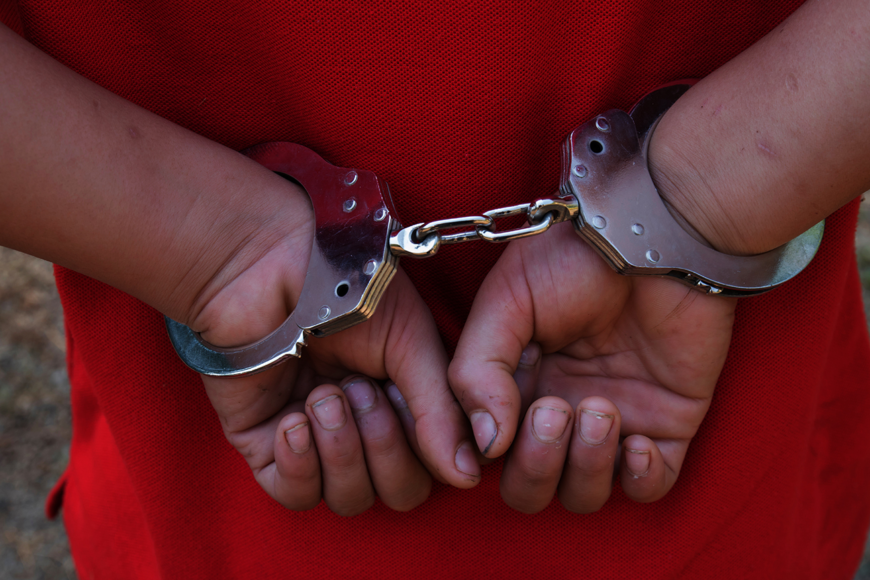How Many Children Are Handcuffed in Upstate New York? Policies and Practices Inconsistent Among Police and Sheriff’s Departments

By Steven Yoder
November 11, 2025
Before a fourth-grader was sprayed with tear gas in 2021 and forced into the back of a Rochester, New York, squad car, an officer shouted: “You’re acting like a child!”
“I am a child!” the girl screamed back.
In recent years, children as young as 8 and 9 have been handcuffed during interactions with police in upstate New York — a law enforcement practice considered not only unnecessary in all but the most extreme situations, but deeply harmful for the kids involved.
Although a handful of high-profile arrests caught on video and shared with the media have drawn the public’s attention to arrests like these, there are no state statistics that track how often young kids are handcuffed. It’s a statistic that sometimes is collected for adults.
An Imprint canvass of the largest upstate law enforcement agencies found few policies governing the practice — with only one department accounting for how frequently the handcuffing of children occurs.
“Interactions with police, especially when there is something like handcuffing or any kind of force involved, are traumatic experiences for a lot of young people,” said attorney Shelley Jackson, who focuses on law enforcement policies for the nonprofit Strategies for Youth.
After such incidents, law enforcement officials sometimes say that what officers did is consistent with department policy, she said. “But when we investigate, we find out that they really don’t have any policy that’s specific to youth.”
A scene captured from the bodycam of a Rochester police officer showing a 9-year-old girl who was pepper sprayed after being taken into custody and handcuffed.
Her organization recommends that all law enforcement agencies adopt policies that bar officers from handcuffing children under age 13 who are compliant, not resisting and pose no risk to another person.
There is little research about the effect of handcuffs on children. But studies since 2019 have found that police stops involving officers handcuffing, frisking or using physical force on children leads to missed days of school, signs of depression, and greater cynicism about laws and police.
Youth advocates have long pushed back against shackling young people. And in 2015, the American Bar Association urged all federal, state, local, territorial and tribal governments to halt the use of mechanical restraints aside from “only the rarest of circumstances.” A 2021 New York State law forbids shackles in family court except in narrow circumstances.
“Feelings of shame and humiliation may inhibit positive self-development and productive community participation,” the bar association reports. “Shackling doesn’t protect communities. It harms them.”
To date, NY legislative attempts to bar handcuffing of little kids have failed
In 2021, New York enacted a law banning the arrest and prosecution of children younger than age 12. But those children are still subject to “Terry” stops — brief detentions that are not considered arrests, in which an officer is supposed to have reasonable suspicion of criminal activity.
State law does not address whether officers can use handcuffs on children during Terry stops, instead leaving it up to individual police department policies. But most departments surveyed by The Imprint have no policy and defer to the discretion of individual officers.
“Shackling sends the message to the child, and anyone who learns that the child was handcuffed, that a child is dangerous.”
— Betsy Kramer, Lawyers for Children
Betsy Kramer of the New York City-based Lawyers for Children expressed dismay that young kids continue to be handcuffed. “Shackling sends the message to the child, and anyone who learns that the child was handcuffed, that a child is dangerous,” she said in an email to The Imprint. That in turn increases the likelihood that the child will be treated as dangerous by others, she said.
Kramer called it “shocking” that “we are still asking whether it is appropriate to indiscriminately handcuff young children.”
Meanwhile, several proposals to prohibit handcuffing during stops have died in the New York state legislature. A bill introduced Jan. 23 by Assemblymember Catalina Cruz, whose district is in the New York City borough of Queens, would have barred police from handcuffing or forcibly restraining children 12 or younger unless they present a danger. Her legislation would also have established a hotline allowing officers to consult with youth specialists.
That bill failed to proceed in the state Assembly. Prior versions of the legislation, sponsored by former Assemblymember Kenny Burgos, died in committee in the last two state legislative sessions.
“It’s like so many other bills,” Martin Feinman, former director of delinquency training in the Legal Aid Society of New York’s juvenile rights practice, told The Imprint in May. “Anything that is perceived as interfering with or limiting law enforcement from doing things the way they want to do it, whether they really have the data to support the need for it or not, meets with a tremendous amount of resistance.”
Few policies, little data
The Imprint contacted the police departments in the five most populous cities in upstate New York as well as sheriff’s departments in the region’s five most populous counties to ask whether they have policies regulating officers’ use of handcuffs on children younger than age 12 during Terry stops.
Of the 10 departments contacted, two stated that they have policies: police departments in Syracuse and Rochester. The Rochester Police Department’s order, which took effect in December 2021, forbids officers from handcuffing youth they believe are age 12 or younger “unless the juvenile presents a danger to themselves or others.” It adds that youth not being arrested or taken into custody should not be handcuffed while they’re transported, unless they present such dangers.
The Syracuse Police Department’s policy, dated April 7, 2022, notes that youth under 14 years old “should not be restrained” unless they’re “suspected of a dangerous felony” or when the officer has a reasonable suspicion that the juvenile may “resist, attempt escape, injure themselves, injure the officer or damage property.”
“I can tell you that that had a psychological impact on me for a very long time. The trauma that created, the hysteria that created, the lack of trust that I developed for public institutions like our police.”
— Connecticut state Sen. Herron Gaston
Three other departments, the Albany and Yonkers police departments and the Erie County sheriff’s department, replied by email that they have no policy.
Five others — the Buffalo police department and sheriff’s offices in Monroe, Rockland, Orange, and Westchester Counties — did not respond to repeated requests for information. Publicly available department policies in those five jurisdictions make no mention of rules for officers regarding handcuffing children during stops.
Only one of the five responding departments, Yonkers, said it keeps statistics on the number of handcuffing incidents of children younger than age 12. From 2022 to 2024, that department recorded no such cases, said Detective Lt. Frank DiDomizio.
Thus it remains unclear how often such restraints are used. DiDomizio stated that in more than 14 years on the force and in talking to other officers with even more experience, he’s never heard of a case of Yonkers police handcuffing a child 12 or younger.
But in January of last year, officers in the neighboring city of White Plains handcuffed a 13-year-old girl who’d called police for help because of a panic attack.
The agencies that have no policies about cuffing young children were asked what criteria officers consider before using such restraints.
Spokespeople for the Albany and Yonkers police departments and the Erie County Sheriff’s Office said by email that they leave the decision to the discretion of officers.
Where kids have been handcuffed
In the two upstate cities with policies, young children have still been handcuffed in recent years. In Syracuse in July 2022, officers cuffed an 8-year-old they suspected of involvement in a robbery with a BB gun.
In a January 2025 incident, Onondaga County sheriff’s deputies in Syracuse handcuffed an 11-year-old girl for seven minutes, saying she matched the description of someone involved in a nearby car theft. She was stopped walking home from school with two friends, and sobbed as she became increasingly fearful after a pair of officers detained her.
After this 11-year-old Syracuse girl in handcuffs was seen in a viral video, Onondaga County Sheriff Tobias Shelley pledged to have his department notify a parent or guardian if a child is detained. Photo: video still.
In a press release the day after the incident, the sheriff’s office stood by the deputies’ actions as routine, noting that “detainees are usually handcuffed initially.” Immediately handcuffing those who are stopped, including children and youth, “usually prevents a controlled situation from devolving into an uncontrolled situation, ultimately preventing altercations, force, and potential for injury,” it stated.
In Rochester, officers handcuffed and pepper-sprayed a 9-year-old girl in distress in January 2021. The Rochester police union noted at the time that an officer had handcuffed the same girl a few weeks earlier after responding to a call at her house. Police had also handcuffed a 12-year-old girl a few weeks earlier, according to an interview a local TV station did with the girl’s mother. And last year, a police accountability board report on Rochester police documented the case of an 8-year-old being handcuffed and taken to the hospital, though the report didn’t provide a date.
Connecticut bars police from handcuffing kids
Young children are handcuffed by police across the country, according to a national study published in the Criminology and Public Policy journal in 2022. Researchers examined police interactions with children from socioeconomically disadvantaged urban families, who are disproportionately children of color, and interviewed 2,614 15-year-olds.
More than a quarter reported having been stopped by police at least once. Of those stopped, 22% reported having been handcuffed. At the time of the stop, they were 13 years old on average. Only 13% reported having been arrested following the stops.
Connecticut tackled the issue in July, becoming the first state to enact a ban on cuffing young children. The new law, signed by Gov. Ned Lamont, bars police from handcuffing someone they know to be age 14 or younger. Exceptions exist when a young person is using or threatening to use violence against the officer, or when the officer determines that not using handcuffs would endanger public safety.
State Sen. Herron Gaston, one of the Connecticut bill’s co-authors, spelled out why the new law curtailing the use of force on children matters. As a 14-year-old, Gaston was detained and held at gunpoint by police after he and his brother were stopped for driving a “suspicious vehicle,” he told Inside Investigator, a Connecticut news outlet.
“I can tell you that that had a psychological impact on me for a very long time,” Gaston said. “The trauma that created, the hysteria that created, the lack of trust that I developed for public institutions like our police.”
Another Connecticut legislator said the new law doesn’t prevent police from handcuffing someone.
“What it does is it says: ‘Stop and think,’” Connecticut House Judiciary Chair Steve Stafstrom told Inside Investigator. “Stop and think whether that child — based on what they did or rather what they are alleged to have done — deserves to go through that traumatic experience of being handcuffed.”
One policing expert said policies barring the cuffing of children are only a start. Nikki Jones, a professor of African American Studies at the University of California-Berkeley, researches police encounters with the public, especially Black youth in high-surveillance neighborhoods.
Policies offer a “hook for accountability,” but it’s important to have buffers between children and the police — such as mobile crisis response teams, Jones said. Police aren’t trained to interact with children and see Black children as older and more threatening than they are, she added.
“What I’m saying might sound strange, but in fact I think we should keep the police far away from children,” she said. “And certainly we shouldn’t have officers routinely applying handcuffs to children.”

